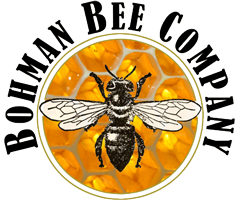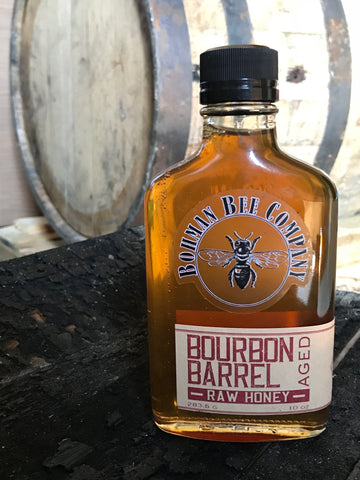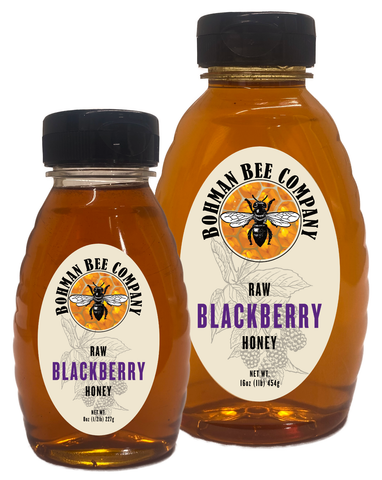FAQs
How is honey made?
Honey is just bee barf right? Not really. Actually, honey starts its journey to the hive from flowers, as nectar. It is collected from the blooms by the honeybee using its long tube-like tongue. The bee stores the nectar in an extra stomach or “crop”. While in the crop, the chemical composition and PH level of the nectar is changed for better long-term storage. When the worker bee returns to the hive, it transfers the nectar to another bee by delivering the sweet liquid from its crop to the second bee’s mouth. The second bee transfers the nectar into the honeycomb for its transformation into honey. However, the nectar is not yet the thick honey that we know. The bees must remove most of the water that is found in the nectar. This is done by fanning. There are bees at the entrance and throughout the hive that fan their wings to circulate air and speed the evaporation process. Once the correct amount of water is removed from the nectar, the bees cover the new honey with a beeswax cap. Eventually, we as beekeepers, remove some of this capped honey from the hives, and extract the honey from the honeycomb to later be enjoyed by you.
My honey is starting to sugar, what does this mean?
It is perfectly natural for raw honey to crystallize over time. It does not mean that the quality of the honey has been affected. There are two types of sugar in honey: fructose and glucose. Honey that is high in fructose rarely crystallize. However, honey that primarily contains glucose is more likely to sugar. Crystallization is natural and does not affect the flavor of the honey. Honey is less likely to sugar if it is stored at room temperature.
My honey has sugared, what do I do now?
It is easy to re-liquefy your honey. Stand your lightly sealed bottle into a bowl of warm water for 20 minutes or simply run it under a hot tap. The honey will gently re-liquefy. You will want to stir up the honey to ensure even warming.
Does honey ever spoil?
Honey never spoils! Edible honey was even found in Egyptian tombs thousand of years later.
What is "Raw" honey?
"Raw" honey is honey that essentially comes straight from the hive. It has not been ultra heated, pasteurized, or filtered. At Bohman Bee Company, we never heat our honey above the temperature of a hive. Our honey is never filtered, it is only screened to remove pieces of wax and other impurities. Find out more by reading our blog post "Raw vs. Processed".
Why is the honey different colors?
Honey's color and flavor is dependent on the nectar sources from which bees forage. With the changing seasons and floral sources, each harvest will have a different color and flavor. We have found that our spring harvest typically is a light colored honey and is very sweet. Our fall harvest is usually much darker and has more of an earthy, robust flavor.
Will honey help with my allergies?
There is some debate on the benefits of honey on allergies. We have many people insist that it alleviates their allergy symptoms. It is believed that the small bits of pollen in the honey builds your body's immunity to pollen allergies. We suggest that you take a tablespoon of honey a day and find out for yourself.
Why should honey not be fed to children under 1 year old?
Botulinum endospores are found in the natural environment of dirt and dust, and the spores can contaminate honeys. For adults and children over one, the digestive system has developed to the point where these spores can be digested. However, infants are not able to digest this spore and could develop botulism. Although botulism cases are rarely traced to honey, we suggest that honey not be given to infants under one.
How many hives do you have?
We now have over 250 hives located in 10 apiaries throughout Indiana.
What is happening to the bees? What can I do to help?
There has been a lot of talk recently about the disappearance of bees and colony collapse disorder (CCD). This has caused a lot of concern and for good reason. It is estimated that bees pollinate up to one-third of the world's crops contributing $15 billion annually to the US economy. What is colony collapse disorder? There is not any one cause for CCD, but many blame pesticides, habitat loss, and parasites. We haven't lost hope yet. There are some things that you can do to help the bees such as planting flowers that attract, don't use pesticides such as neonicotinoids, or start your own backyard beehive.
There is a mass of bees in my yard, what should I do?
This is called a swarm. The bees are not dangerous at this time and are rarely defensive (they don't have a home to defend). When a hive swarms, they will create a new queen. Then the old queen and roughly half of the hive will leave to start a new colony. They will pile up in a tree or fence line and send out scout bees to look for a new home. Once they have found a place to live, such as a hollow tree, they will leave as a dark cloud of bees. The swarm will usually disappear in a day or two. However, if you would like to have them removed, call a local beekeeper. Do not call an exterminator!
How can I get started beekeeping?
There are many resources that will help you get started. We often suggest the book, The Backyard Beekeeper by Kim Flottum. One of the best ways to learn beekeeping is to start two or three hives. This will allow you to try different things, experiment, and see what works best. If you really want to get started, give us a shout at bohmanbeecompany.com or 812-292-1076, and we will get you going in the right direction.


